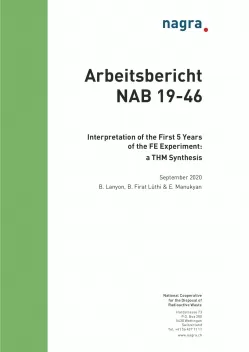
Arbeitsbericht NAB 19-46
Interpretation of the First 5 Years of the FE Experiment: a THM Synthesis
The Full-Scale (FE) Emplacement Experiment
The 'Full-Scale Emplacement' (FE) Experiment simulates, as realistically as possible, the construction, waste emplacement, backfilling and early stage thermo-hydro-mechanical (THM) post-closure evolution of a spent fuel (SF)/vitrified high-level waste (HLW) disposal tunnel according to the current Swiss repository concept (Müller et al. 2017). Nagra (2019) presents a synthesis of the design, construction and preliminary results of the FE Experiment up to the first 18 months of heater operation.
The objectives of the FE Experiment are:
- to investigate SF/HLW repository-induced THM coupled effects on the host rock at full scale and to validate existing coupled THM models
- to verify the technical feasibility of constructing an emplacement tunnel using standard industrial equipment
- to optimise the bentonite buffer material design and production, in particular to produce bentonite blocks that are capable of resisting the ambient conditions during the emplacement and operation phases
- to investigate (horizontal) canister and buffer emplacement procedures for underground conditions
The latter three objectives have been largely addressed in Nagra (2019) and so the emphasis here is on the first objective.
Practical considerations regarding instrumentation and construction at the Mont Terri Under-ground Rock Laboratory (URL) limit the scope of the investigations possible. In particular the design of the plug is not fully airtight which may result in a different gas phase evolution from that expected in a repository. Further, the FE Experiment was not designed to address demon-stration of retrievability. Transferability of observations and process understanding (Mazurek et al. 2008) derived from the FE Experiment needs to take account of the different lithologic, tectonic, temperature, stress and pore pressure conditions at the Mont Terri URL from those prevailing at candidate repository sites.
The FE Experiment was undertaken by Nagra in collaboration with a range of partners including ANDRA, BGR, US DOE, FANC, GRS, Posiva, SKB and NWMO. Not all partners have participated in each phase of FE. The construction of the FE experiment was part of the European Union (EU) Large Underground Concept Experiment (LUCOEX) Project, which focused on demonstration of the technical feasibility of safe and reliable disposal of radioactive waste in geological formations.
